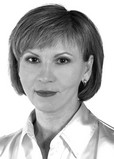Anthropometric profile of gender status of modern youth
Фотографии:
ˑ:
PhD, Associate Professor T.V. Artamonova1
PhD, Associate Professor V.V. Steshenko2
1Bauman Moscow state technical university, Moscow
2Volgograd State Social and Pedagogical University, Volgograd
Objective of the study was to identify the peculiarities of correlation between the anthropometric characteristics of gender-differentiated individuals.
Methods and structure of the study. Sampled for the study were the 19-year-old students of the Volgograd State Socio-Pedagogical University (FSBEI HE "VSSPU") (n=34, including 15 boys and 19 girls).
To determine the "masculinity/ femininity" index we used the test questionnaire developed by S. Bem. The anthropometric measurements were taken using the standard techniques. The following parameters were measured: neck circumference, wrist circumference, chest circumference, shoulder width, pelvis width. The index of sexual dimorphism (Tanner index) was measured in centimeters by calculating the difference between the triple value of the width of shoulders and the width of pelvis. To identify significant correlations between the indicators of the studied anthropometric parameters and the value of the gender index, a correlation analysis of the results was carried out according to B. Pearson's method. We determined the presence of significant correlations between the studied indicators in the general group of respondents, then separately in the group of males and separately in the group of females (on the basis of sex), after which - in masculine and feminine students (on the basis of gender).
Results of the study and conclusions. According to the anthropometric measurements, in masculine males the neck circumference is significantly larger than in feminine ones, while the chest circumference is significantly larger in feminine males. No significant differences were found between the anthropometric measurements in the masculine and feminine females.
The findings can be used to clarify data on the laws of constitutional variability of physical status at a young age, and to conduct cross-cultural studies on this topic.
Keywords: anthropometric measurements, students, gender, masculinity, femininity.
References
- Artamonova T.V., V.V. Steshenko Morfologicheskie kriterii gendernoy identifikatsii []. Uchenyie zapiski universiteta im. P.F. Lesgafta. 2017. # 7 (149). pp. 7-11.
- Butovskaya,M.L., E.V. Veselovskaya, A.V. Kondrateva, E.A. Prosikova Antropologiya i psihologiya dlya sporta. Vyiyavlenie psihosomaticheskih kompleksov u sportsmenov-edinobortsev [Anthropology and Psychology for Sport. Identification of psychosomatic complexes in martial artists]. Meditsina dlya sporta» [Medicine for Sports). Proc. I All-Russian Congress (Moscow, September 19-20, 2011); Available at: http://www.sportmedicine.ru/medforsport-2011-papers/butovskaya.php (date of access: 20.06.2017).
- Burgart V.Yu., N.N. Medvedeva, I.A. Zaliznyak Antropometricheskie markeryi androgennoy nasyischennosti u yunoshey raznyih tipov teloslozheniya [Anthropometric markers of androgenic saturation in young men of different body types]. Estestvoznanie i gumanizm: sb. nauch. tr. v. 3, # 1. Tomsk, SSMU. 2006. pp.64-66.
- Vrublevskiy E.P. Otbor i podgotovka sportsmenok v legkoy atletike s pozitsii polovogo dimorfizma [Selection and training of athletes in athletics in context of sexual dimorphism]. Zdorove dlya vseh. 2010. # 1. pp. 51-54.
- Zamchiy T.P., Yu.V. Koryagina Polovoy dimorfizm v morfologicheskih harakteristikah sportsmenov silovyih vidov sporta [Sexual dimorphism in morphological characteristics of power sports athletes]. Sovremennye problemy nauki i obrazovaniya. 2011. # 3; Available at: https://science-education.ru/ru/article/view?id=4676 (date of access: 25.06.2017).
- Kolokoltsev M.M. Dvigatelnye kachestva yunoshey-studentov s raznyimi in-deksami polovogo dimorfizma [Motor qualities of youth students with different indices of sexual dimorphism]. Teoriya i praktika fiz. kultury. 2016. # 6. P. 14.
- Kornetov N.A. Integrativnaya antropologiya: ot meditsinyi k filosofii [Integrative anthropology: from medicine to philosophy]. Novye idei v filosofii. 1997.no. 6. pp. 32-41.
- Lubysheva L.I., A.A. Badrtdinova Osobennosti gendernoy sotsializatsii zhenschin, zanimayuschihsya traditsionno muzhskimi vidami sporta [Gender-specific socialization challenges for women engaged in traditionally men's sports]. Teoriya i praktika fiz kultury. 2017. # 5. p. 2.
- Svistunova E.V. Ispolzovanie metodov artterapii dlya diagnostiki i korrektsii narusheniy polovoy identichnosti [Art therapy methods for diagnosis and correction of gender identity disorders]. M.: MSPU; Available at: http://www.phil.gu.se/sffp/reports2/27. Svistonova.pdf (date of access: 25.04.2018).
- Grets I.A., G.N. Grets, I.M. Silovanova Estimation of score of sexual dimorphism by morphofunctional characteristics of elite throwers. Teoriya i praktika fizicheskoy kultury. 2013. no 5. p. 68.



 Журнал "THEORY AND PRACTICE
Журнал "THEORY AND PRACTICE